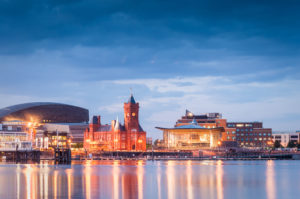Apr4
Sustainable drainage systems (SuDS) on Welsh new developments are now mandatory
Posted by Ashlea Williamson

New legislation from the Welsh government, which came into effect on 7 January 2019, stipulates that all new developments of more than one dwelling or where the construction area is 100m2 or more should have Sustainable Drainage Systems (SuDS) in place.
From this date onwards, SuDS on a new development must be designed and built in accordance with the Statutory SuDS Standards published by the Welsh Ministers, while SuDS schemes must be approved by the local authority acting in its SAB role, before construction work begins.
Alumasc WMS have always worked with the philosophy that surface water from both roof and ground level is a valuable natural resource which should be managed in a way that reflects this. This is not only in the interests of the surrounding environment but also to create better places for people to live, work and play.
With this in mind, we believe water management should be considered from the beginning of the development process and throughout, and that it should positively influence the design and layout of the project or space.
So, how can you implement SuDS in your project when it comes to roofing and water management?
The core aim of SuDS is to manage rainfall in a way as similar to the natural process as possible, making use of surrounding landscape and natural vegetation to control the volume and flow of surface water. The benefits of SuDS can encompass flood risk reduction, enhanced biodiversity, creation of natural habitats for wildlife, contribution to better mental health and much more.
Both Green and Blue Roof systems offer SuDS measures, intended to significantly reduce peak rates of rainwater runoff, especially during heavy rainfall. This is not limited to during the event of a storm. As a general rule in the UK, London and East Anglia receive high intensity rainfall incidents, whereas western aspects of the UK generally receive higher total rainfall. So, its not just Cardiff, officially the UK’s wettest City, but the whole of the UK that would benefit from Green and Blue Roof technology.
Green and blue roofs do this is in different ways but can be used in conjunction with each other. Blackdown Greenroofs, for example, retain rainwater through plant absorption and provide replacement of lost animal habitats through the introduction of natural vegetation, occupying otherwise redundant roof space and providing a great opportunity to create new amenity space for people to use for recreation and increased overall wellbeing—a real benefit in dense urban spaces.
Alumasc BluRoof rainwater outlets may be used to drain the excess runoff that is not absorbed by a green roof. They do this in a controlled way, using specially designed flow restrictors: the attenuated stormwater is temporarily kept at roof level for controlled discharge — integral to the mitigation of flood risk. The number and aperture diameters of which are calculated individually per job, to reduce the rainwater discharge to a specific maximum rate advised by the designer. In this way, clients can be confident that an Alumasc BluRoof system can be trusted to provide a water management solution that is tailored bespoke to their needs.
With an Alumasc BluRoof, grey water can be attenuated at roof or basement level and re-used within the building, for applications such as air conditioning or toilets after filtering. This results in less water consumption by the building, and less rainwater discharge into sewer systems: both more environmentally friendly, and more economical. On large commercial schemes this can create client cost savings in the £100,000s per annum.